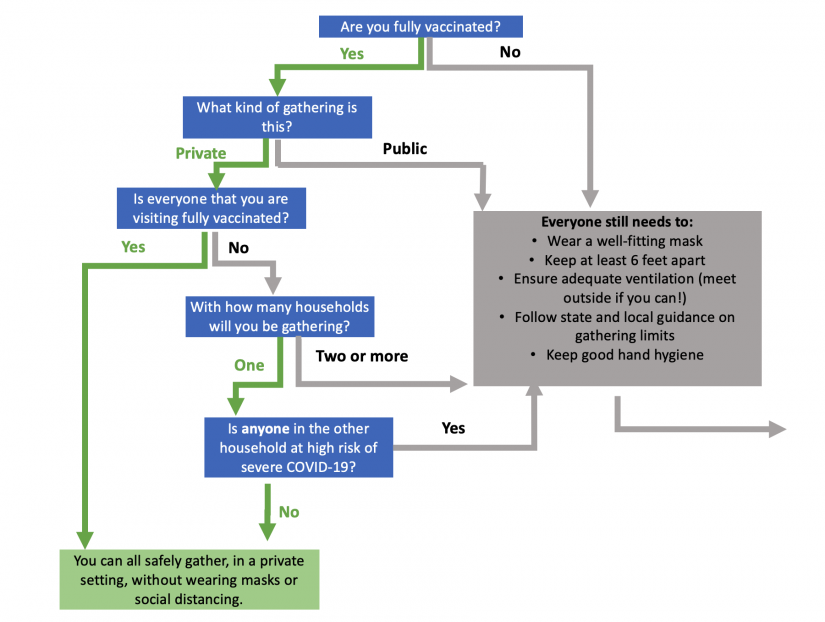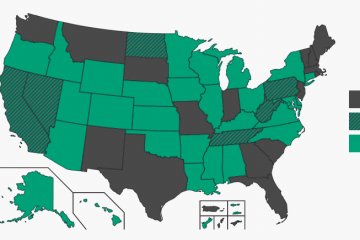The Centers for Disease Control and Prevention recently released guidance for individuals who have been fully vaccinated with a COVID-19 vaccine available under Emergency Use Authorization by the Food and Drug Administration. This guidance pertains to gatherings, quarantine, and travel restrictions.
While a fully vaccinated person is well protected against disease, they need to be respectful of others who may still be at risk of infection and who have not received the vaccine. We still need more data on vaccine efficacy against new variants, efficacy in children, and efficacy on preventing transmission.

Image caption:Text-only version of this flow chart available here.
What does a "fully vaccinated individual" mean?
A person is considered to be "fully vaccinated" after at least two weeks past their second dose of the Moderna or Pfizer/BioNTech vaccine, or at least two weeks after their single dose of the Johnson & Johnson vaccine. This two-week period gives the body time to establish a strong immune response after the second dose. For now, no vaccine has been authorized for use in anyone under age 16.
What does the guidance mean for fully vaccinated individuals in public gatherings or settings?
In public settings—like restaurants, houses of worship, and gyms—fully vaccinated individuals should continue wearing masks, social distancing, and washing hands frequently.
What does the guidance mean for fully vaccinated individuals visiting only with other fully vaccinated individuals?
Fully vaccinated people visiting only with others who are fully vaccinated in a private setting do not have to wear masks or social distance.
What does the guidance mean for fully vaccinated individuals visiting with a single household?
Fully vaccinated people visiting with a single household in a private setting do not have to wear masks or social distance if all unvaccinated people in the other household are at low risk of severe COVID-19.
If anyone in the other household is at high risk of severe COVID-19 and has not been vaccinated, then everyone—including the fully vaccinated individual(s)—should continue to wear masks, social distance, wash hands, and continue following CDC guidance for public gatherings.
What does the guidance mean for households with children?
Fully vaccinated individuals can visit without masks and without social distancing with a single household, including children, if everyone in that household is healthy and at low risk of severe COVID-19. The CDC guidance does not mention two households visiting, both with children, if the adults are fully vaccinated.
Should more than two households gather without masks or social distancing?
No. In a setting where fully vaccinated individuals will be gathering with more than one other household, everyone should continue to wear masks, social distance, wash hands, and continue following CDC guidance for public gatherings.
The CDC is still recommending that everyone, even those who are vaccinated, avoid medium to large gatherings in public (like concerts, weddings, and funerals). If they do attend, it's important to follow CDC guidance for such situations.
What if a fully vaccinated individual is exposed to a known COVID-19 case?
They should watch for symptoms for 14 days. Even if they have had the vaccine, there is a small chance that they could develop COVID-19. If they do not develop symptoms, there is no need to quarantine or be tested for SARS-CoV-2. If they do develop symptoms, they should isolate, contact their health care provider, and be tested for SARS-CoV-2.
However, if a fully vaccinated person lives in a congregate setting (like a group home or correctional facility) and is exposed to a COVID-19 case, they should quarantine for 14 days.
I've been fully vaccinated—can I travel?
The CDC has not updated their guidance on travel restrictions and requirements. For now, it's best to not travel unless you absolutely have to. If you do, it's important to follow all CDC, state, and local guidance on travel restrictions and requirements (like testing and masking).
I haven't been vaccinated yet—what does the guidance mean for me?
In public or when visiting with multiple households, you should continue to follow CDC guidance: Wear a mask, social distance, wash your hands, and avoid crowded settings.
When gathering with fully vaccinated people from a single household in a private setting:
- If you are at low risk of severe COVID-19 and live alone, then you do not have to wear a mask or social distance.
- If you and all members of your household are at low risk of severe COVID-19, then you do not have to wear a mask or social distance.
- If you or anyone in your household is at high risk of severe COVID-19, then everyone who is gathering should wear a mask, social distance, and practice good hand hygiene.
Rachel West is a postdoctoral associate at the Johns Hopkins Center for Health Security and the W. Harry Feinstone Department of Molecular Microbiology and Immunology at Johns Hopkins Bloomberg School of Public Health.
This article originally appeared on the Expert Insights website of the Bloomberg School of Public Health.
Posted in Health
Tagged covid-19 vaccine









